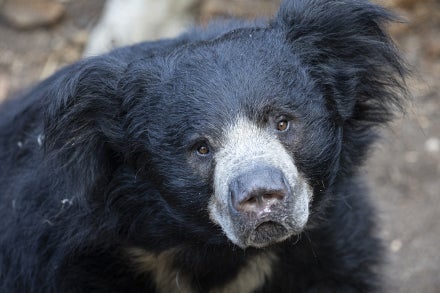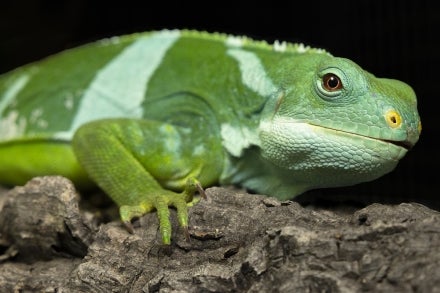Image

 The estimated percentage of the animal and plant products in our diets that can be traced, both directly and indirectly, to insect pollination.
The estimated percentage of the animal and plant products in our diets that can be traced, both directly and indirectly, to insect pollination.

 The percentage of decline in overwintering monarch butterflies in the Central Mexican butterfly preserves from the 20-year average, as measured in the winter of 2013-2014.
The percentage of decline in overwintering monarch butterflies in the Central Mexican butterfly preserves from the 20-year average, as measured in the winter of 2013-2014.

PESTICIDES
All insects are affected by contact with insecticides. A newer class of systemic insecticides called neonicotinoids has been shown to severely affect bee health. In agriculture, this type of insecticide is most often applied as a seed coating, and the insect nerve poison subsequently shows up in every tissue as the plant grows: leaf, stem, pollen, and nectar. As a result, though the insecticide is targeted at “pest” insects, there can be serious consequences for any insect that visits the plant for nectar or pollen. Some need only be present when the planting occurs, since some of the chemical seed coating is released as crop “dust” in agricultural plantings. The effects of these pesticide exposures include immediate death by contact, but some are sublethal, meaning that the animal does not die right away but experiences disorientation, loss of navigational ability, paralysis, and even memory loss as the result of contact.
This is not just an agricultural issue; many products containing this type of insecticide can be found in local home improvement stores for landscaping use. Federal regulations govern the concentrations of these poisons used in agriculture, yet there are no restrictions for home use, and that sets up a dangerous scenario. Consumers often do not follow the instructions for application and the concentrations can be many times higher than federal regulations allow. This means more of the poison finds its way to bees and other animals through gardens and runoff from irrigation.
It is important to note here that the majority of research on pesticide effects in pollinators has been conducted in honeybees because they are managed commercially, making them more accessible and measurable. Since their biology is very similar to that of native bees, we can assume that the damaging effects from pesticides are also suffered by native bees.
Why are native bees important? Because no pollinator serves our plants better. Native bees have evolved alongside the flowering plants that they pollinate, and they are usually much better at it than non-native honeybees. It’s easy for honeybees to get all the attention, because they are used in commercial agriculture and are relatively easy to study. But native bees such as mason bees, mining bees, and leafcutter bees have been quietly carrying their weight in our ecosystems for millennia.
[caption id="attachment_36898" align="aligncenter" width="727"]
As a result, though the insecticide is targeted at “pest” insects, there can be serious consequences for any insect that visits the plant for nectar or pollen. Some need only be present when the planting occurs, since some of the chemical seed coating is released as crop “dust” in agricultural plantings. The effects of these pesticide exposures include immediate death by contact, but some are sublethal, meaning that the animal does not die right away but experiences disorientation, loss of navigational ability, paralysis, and even memory loss as the result of contact.
This is not just an agricultural issue; many products containing this type of insecticide can be found in local home improvement stores for landscaping use. Federal regulations govern the concentrations of these poisons used in agriculture, yet there are no restrictions for home use, and that sets up a dangerous scenario. Consumers often do not follow the instructions for application and the concentrations can be many times higher than federal regulations allow. This means more of the poison finds its way to bees and other animals through gardens and runoff from irrigation.
It is important to note here that the majority of research on pesticide effects in pollinators has been conducted in honeybees because they are managed commercially, making them more accessible and measurable. Since their biology is very similar to that of native bees, we can assume that the damaging effects from pesticides are also suffered by native bees.
Why are native bees important? Because no pollinator serves our plants better. Native bees have evolved alongside the flowering plants that they pollinate, and they are usually much better at it than non-native honeybees. It’s easy for honeybees to get all the attention, because they are used in commercial agriculture and are relatively easy to study. But native bees such as mason bees, mining bees, and leafcutter bees have been quietly carrying their weight in our ecosystems for millennia.
[caption id="attachment_36898" align="aligncenter" width="727"] CONCENTRATING NECTAR
CONCENTRATING NECTARSome bees have a different way of transporting pollen. This female masked bee, or Hylaeus, is about to concentrate a drop of nectar to make it easier to carry back to her nest. By drawing the droplet in and out of her mouth repeatedly, moisture evaporates and the nectar becomes more of a pellet than a drop. She will then swallow it and regurgitate it back at the nest. Masked bees are a solitary species that often use old burrows of other insect species for a nest. [/caption]

HABITAT MATTERS
As human populations grow, less space remains for native pollinators to thrive. Overgrown spaces with wildflowers, weeds, and nesting sites are disappearing, banished in favor of manicured lawns that eliminate key nectar and pollen sources—like dandelions—and encourage pesticide use. Agricultural practices also alter land that was once suitable pollinator habitat. Instead of a diversity of nectar and pollen sources, acreage is filled with insecticide- and herbicide-laden monocultures as far as the eye can see. Two types of genetically modified (GM) crops are routinely used in agriculture. One is an insect-resistant type, in which a bacterium that is lethal to certain chewing insects is incorporated into the genome of the plant, and the target insect species are killed when they feed on the plant. The second is an herbicide-resistant variety, which is definitely a problem for pollinators, especially butterflies and bees. In herbicide-resistant GM crops, the plants are engineered to be resistant to applications of certain herbicides. They can withstand repeated applications of herbicide, which kills all the flowering weeds surrounding the planted area—the ones the pollinators depend on. [caption id="attachment_36900" align="aligncenter" width="730"] DISAPPEARING BEAUTIES
DISAPPEARING BEAUTIESMonarch butterflies have been in the spotlight lately due to an alarming decline in their numbers. [/caption] This is of particular concern for monarch butterflies, whose larval host plant is milkweed. Milkweed thrives in disturbed habitats and has historically been found adjacent to crops. Most people are familiar with the epic migration of the eastern monarch butterfly population to the oyamel fir tree forests of Central Mexico. Over the past few years, the count of overwintering monarchs in the protected reserves has revealed a catastrophic drop—down an incredible 90 percent from the 20-year average and standing at an all-time historical low since the migration was discovered in the 1970s. Lack of available host plants due to GM-related herbicide application has been identified as a key factor in this staggering decline.

DISEASE
There are a great many parasites and pathogens that burden pollinators, and the ones causing the most damage are introduced species. Native bumblebees suffer from a non-native fungal disease, while honeybees struggle with introduced ectoparasites such as varroa mites and fungal infestations from nosema spores. A combination of all these—and probably other—factors has created the phenomenon known as Colony Collapse Disorder, which is decimating honeybee colonies in the United States. The precise cause is still unknown because the bees simply disappear, taking the evidence with them. But one thing is clear: life is hard for honeybees these days. [caption id="attachment_36903" align="aligncenter" width="730"] A HEAVY LOAD
A HEAVY LOADThis female leafcutter bee Lithurgopsis apicalis has already gathered a good load of pollen but still seeks more. [/caption] [caption id="attachment_36902" align="aligncenter" width="730"]
 POLLINATOR PAIR
POLLINATOR PAIRA honeybee Apis mellifera and a green sweat bee Agapostemon texanus share the bounty of a cactus blossum. [/caption]

CHOOSE AND TELL
The magnitude of the problem makes it seem like there is no stopping it, but the reality is that a steady stream of small choices can help turn the tide. Once threats to pollinators are understood, everyone can contribute to the solution by making different choices. At the San Diego Zoo, we are committed to helping pollinators recover. We’re spreading the word about the pollinator crisis in our education programs and through advocacy of the Pollinator Garden, which is located at the entrance to Elephant Odyssey. This beautiful space is dedicated to helping sustain bees, butterflies, hummingbirds, flies, and beetles by providing a steady supply of pesticide-free nectar and host plants, as well as suitable living spaces for native bees.Helping Pollinators
A NATIVE BEE HOUSE AT THE SAN DIEGO ZOO
Shows a number of ways humans can provide nesting habitat for bees.
 The Pollinator Garden also hosts a monarch waystation. This area includes a dedicated section of native milkweed available for monarch butterflies to lay eggs from spring through fall, helping to boost the West Coast population. Monarchs have deservedly been in the spotlight recently; they have been advocated for endangered species protections due to their alarming decline and the potential threat to the eastern population. In one response to the 2014 Presidential Memorandom “Creating a Federal Strategy to Promote the Health of Honey Bees and Other Pollinators,” the federal government has recently set aside almost $2.5 million for monarch butterfly habitat restoration and educational outreach.
The monarch is a highly recognizable, iconic species—and many more species need our help. As a result, we have just finished construction on a facility for rearing lesser-known imperiled San Diego butterfly species. We are working collaboratively with the U.S. Fish and Wildlife Service in giving some of these endangered pollinators a population boost in the near future. If you have never heard of the quino checkerspot butterfly, the Hermes copper, or the Laguna Mountains skipper, it is our hope that you will learn about them through the efforts of the San Diego Zoo’s Butterfly Conservation Lab—stay tuned!
Beyond butterflies, honeybees also get a hand here at the Zoo. They gather in swarms while looking for a new home, and when they swarm in undesirable spots at the Zoo, we find them a more suitable place to go. For the past two years, we have been maintaining honeybee colonies on grounds and do live removals of swarms and established hives in problem places wherever possible.
[caption id="attachment_36906" align="aligncenter" width="1432"]
The Pollinator Garden also hosts a monarch waystation. This area includes a dedicated section of native milkweed available for monarch butterflies to lay eggs from spring through fall, helping to boost the West Coast population. Monarchs have deservedly been in the spotlight recently; they have been advocated for endangered species protections due to their alarming decline and the potential threat to the eastern population. In one response to the 2014 Presidential Memorandom “Creating a Federal Strategy to Promote the Health of Honey Bees and Other Pollinators,” the federal government has recently set aside almost $2.5 million for monarch butterfly habitat restoration and educational outreach.
The monarch is a highly recognizable, iconic species—and many more species need our help. As a result, we have just finished construction on a facility for rearing lesser-known imperiled San Diego butterfly species. We are working collaboratively with the U.S. Fish and Wildlife Service in giving some of these endangered pollinators a population boost in the near future. If you have never heard of the quino checkerspot butterfly, the Hermes copper, or the Laguna Mountains skipper, it is our hope that you will learn about them through the efforts of the San Diego Zoo’s Butterfly Conservation Lab—stay tuned!
Beyond butterflies, honeybees also get a hand here at the Zoo. They gather in swarms while looking for a new home, and when they swarm in undesirable spots at the Zoo, we find them a more suitable place to go. For the past two years, we have been maintaining honeybee colonies on grounds and do live removals of swarms and established hives in problem places wherever possible.
[caption id="attachment_36906" align="aligncenter" width="1432"] SWEET REWARDS
SWEET REWARDSWhen a beehive was discovered in an irrigation box on the Zoo’s gorilla habitat roof, the bees were carefully relocated. he sweet reward of honey straight from the comb went to the gorillas and other primates! [/caption]





